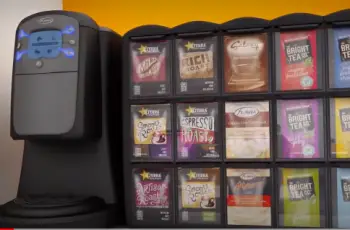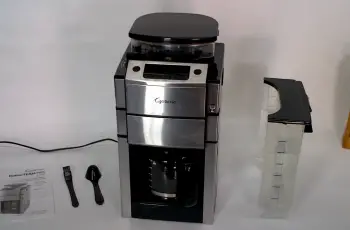Cuisinart stands out as a leading and highly recognized brand in the coffee maker industry today. It also ranks among the top sellers of electric coffee makers on the market. Renowned for its durable, efficient, visually appealing, and reliable coffee machines, Cuisinart has been a trusted name in kitchen appliances since the late 1970s. The brand enjoys a global user base that runs into millions. In this article, we will explore the process of descaling the Cuisinart coffee maker.
You can find a lot of ways to clean or Decalcify your coffee machine. However, not all the procedures are equally effective. Below, we will mention some ways on how to clean or Decalcify the machine easily.
Why It Is Important to Decalcify the Coffee Maker?
You might know that 1 cup of coffee contains 99% of water. So, water makes up the larger portion of coffee. Water contains minerals such as calcium and magnesium, which pass through your coffee and eventually make a build-up on the machine as lime-scale. Decalcification is the process of cleaning that mineral buildup from the inside of the machine.
Decalcification can easily remove various residues like deposits buildup[ from the machine. If you don’t clean or decalcify your machine, mineral scale buildup can negatively affect your coffee machine boiler in several ways, which can affect coffee taste and flavor.
- When buildup accumulates on your machine heating elements, water can’t reach the optimal temperature. And, you will not get the full flavor from your coffee.
- Mineral scale buildup can clog water flow which can malfunction the device. If you don’t remove this buildup, it can cause the machine to stop working.
- The coffee maker will need overworking to take the water to optimum temperature. This will affect the machine’s durability.
How to Decalcify Cuisinart Coffee Maker?
Inside and outside areas of the coffee maker need to be cleaned regularly. Below, we will mention the process of how to decalcify the Cuisinart coffee maker. Following these steps to decalcify your machine easily:
Step 1
At first, remove all the removable parts from your machine. If you have any coffee remaining in the carafe, clean the carafe with clean water. Next, clean the basket if have any coffee grounds or filter paper in it. Put back the parts after cleaning.
Step 2
Now, fill the water reservoir with two parts of water and one part of white vinegar. Then, shake them to mix properly. Remember that, the amount of water and vinegar you use will depend on the size of your coffee maker. For the standard size of the coffee maker, you will need 8 cups of water and 4 cups of vinegar to fill the water reservoir.
Step 3
Press the clean button, if your machine has a self-clean option. When you start the machine, the clean light shines steadily to indicate that the machine is in CLEAN mode. If the cycle is finished, the machine ring 5 times and turns off automatically.
Step 4
If your coffee maker doesn’t have a self-clean function, run a brew cycle manually. After filling the water reservoir, turn ON the machine and run a brew cycle. But, for a deep clean, you need to pause the brew 5-8 minutes later and let the cleaning solution sit inside the machine to work on the buildup effectively.
Step 5
After the first brew cycle, if you see have any build-up inside the machine, you need to run the brew cycle again. Follow the same step we have mentioned above. Let the brew cycle complete as you make the coffee. You might or might not pause the machine during this step.
Step 6
After the second brew cycle is complete, discard the solution from the carafe also remove the all removable part from the machine. Clean all parts with clean water perfectly. Now, fill the carafe with just clean water, run the brew cycle. It helps to reduce the smell of the vinegar from your coffee maker. Otherwise, the vinegar smell can affect your coffee taste and flavor. It’s necessary to do for remove the vinegar flavor.
What are the Alternatives of Vinegar?
Some people don’t like the vinegar smell, that’s why they may not want to use it to clean their coffee machine. If you are one of them, you might employ alternative ways. There are several alternatives to vinegar while cleaning your machine. These ways have the same effect on your coffee maker as vinegar. Below, we mention some alternatives way:
Lemon
Lemon also offers the same level of acidity as vinegar. But, lemon has a charming aroma flavor, available everywhere and everyone can afford it. Also, it has no bitter smell like vinegar. You need to squeeze lemon by hand, to clean your machine. As a natural cleaning solution, you can use it without any tension.
Baking Soda
As an alternative ingredient, you can use baking soda. Baking soda is also a non-toxic natural cleaner. It helps you to clean your machine. The way to clean your machine is similar to the lemon cleaning process. If you want natural cleaning solution, baking soda could be the priority. It gives you the best natural cleaning solutions.
CLR
CLR is the best substitute for lemon and baking soda. It is an easy process to clean your machine using it. Among the commercial cleaning solution, CLR is the best. Remember that, the ratio of CLR is 1 cup of CLR with 4 cups of water and before starting the brew cycle you need to mix both elements properly. You could try this solution for the most effective cleaning.
Note that not all coffee makers may not be suitable for cleaning with CLR. Refer to your user manual to know whether you can use it or not.
Conclusion
As you see above, if you don’t clean your machine, it can create many problems. If you have the right tools and methods in your mind, you can easily clean your machine. We hope you have found the perfect cleaning technique. Now it’s time to implement them to decalcify your coffee maker. Before you begin the cleaning, you should give a look at the coffee maker user manual for further information about the machine.



